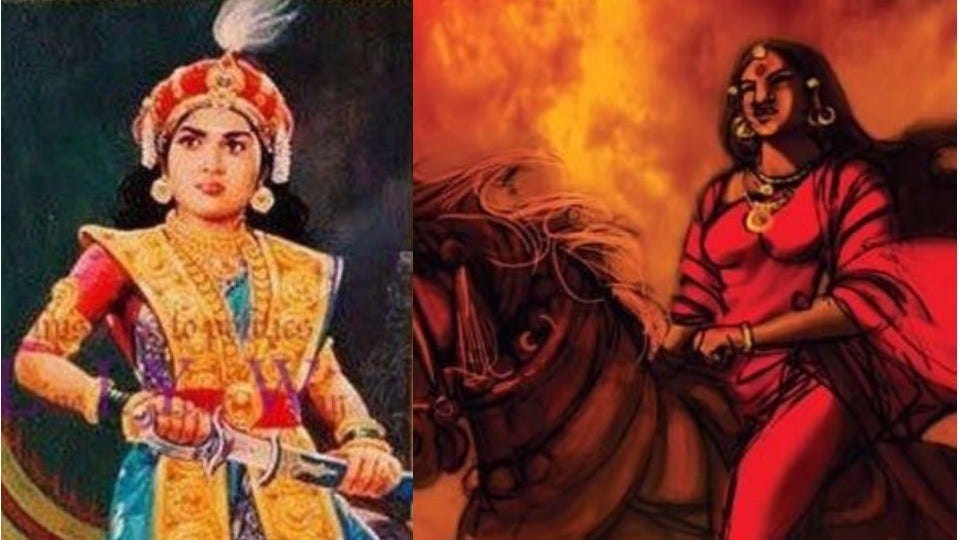Kuyili, The Fearless Indian Woman Who Fought Away the British
The incredible story of Kuyili, the brave commander-in-chief of queen Velu Nachiyar from Tamil Nadu, India.
Queen Velu and the Kingdom of Sivaganga
The year was 1772, and Muthuvaduganatha Thevar, the second king of the Sivaganga state, was fighting a losing battle with the nearby Nawab of Arcot. Normally it would have been a cakewalk for Muthuvaduganatha, whose forces were far superior and armed. However, this time, the Nawab was riding high on the support of the British army, who wanted to oust Muthuvaduganatha and put a puppet in his place.
In the war that took place, Muthuvaduganatha was killed, and his queen Velu Nachiyar escaped to the nearby hills vowing to avenge her husband’s death and take back her kingdom.
As an astute stateswoman, she steadily worked in the background, amassing troops and forging crucial alliances with Mysore kings like Hyder Ali and Gopala Nayaker from Madurai. Soon she had a well-trained and disciplined army under her disposal, raring to take on the British.
The Story of Kuyili
That was when she came across Kuyili, a tall muscled girl whose guerrilla-type attacks were already becoming a thorn in the flesh for the British. Velu Nachiyar made her commander-in-chief of her army as together, both the women made life miserable for the British army stationed at Sivaganga.
That was when Kuyili came up with an audacious plan to infiltrate the Sivaganga fort, bomb the entire armory of the troops that was located on the fort premises, and then open the fort gates for Velu Nachiyar’s army to catch them off-guard when they were at their most vulnerable.
It was festival time, with Diwali celebrated across the country, and the British were only allowing women inside the fort to light the lamps as part of the festivities. Kuyili planned to get a few women soldiers inside the fort under disguise, with weapons hidden inside flower and fruit baskets.
Once inside, she intended to use the ghee (clarified butter) and the oil used for lighting the lamps to burn away the armory chambers near the fort's western side.
The plan was highly successful, with the British army overwhelmed by the chaos and confusion created by Kuyili’s women as they opened the fort gates and caught the British unawares. But despite the surprise, the British were still managing to defend the armory chambers that needed to be destroyed for Velu Nachiyar’s army to win against them.
That was when Kuyili did her supreme sacrifice. She poured ghee and oil that were meant for lighting the lamps upon herself and then walked into the armory chambers with her head held high and set herself on fire.
Kuyili’s sacrifice did not go in vain, as Velu Nachiyar’s army routed the British and captured the fort. She thus not only helped Velu to avenge her husband’s death but also handed over to the British one of their worst defeats in history.
Kuyili is Getting Remembered
After her victory over the British, Velu Nachiyar reigned over the Sivaganga kingdom for a decade. After her, Vellachi, Velu Nachiyar’s daughter, succeeded her to the throne and ruled from 1790 to 1793.
After that, the kingdom of Sivaganga fades away from public memory as the brave exploits of two valiant women who dared to fight and defeat the British get denigrated as mere footnotes in history.
It was only centuries later they are being remembered now. In 2008, a postage stamp was released in the Queen’s name, and the title ‘Veeramangai’ or ‘brave woman’ was bestowed upon her by the government.
The government has also erected a memorial for Kuyili at Sivaganga town, with school textbooks being rewritten to educate today's children about her brave saga of sacrifice and patriotism.
The brilliance, bravery, and sacrifice of Kuyili have forged a new shining chapter for women’s contributions in Indian history that should never be forgotten.
Sources
· Kuyili: The Dalit Commander Whose Sacrifice Remains An Unsung Tale
· Velu Nachiyar & Kuyili: The Women Who Took Down The British 85 Yrs Before 1857!
· The Tamil woman warrior who immolated herself to fight the British Raj
· Why remembering unsung Dalit women heroes matters






